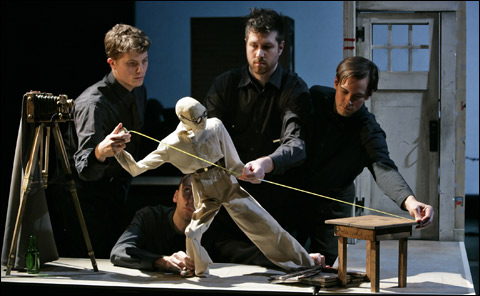
PROFOUND: Dan Hurlin has created a meditation on isolation, aging, sanity, and survival. |
Nobody knew very much about Mike Disfarmer. Even his name was a fabrication. Neighbors in his small Arkansas town ran into him buying beer and ice cream at the local store, or picking up packages at the post office, and he took their pictures in his old-fashioned photography studio. He was just there, odd, taciturn, a fixture. Every town has a character like this: an angry eccentric who’s intensely private but still lives a public life, strange, harmless, almost pathetic in his alienation. Disfarmer’s cache of glass negatives turned up after his death in 1959, and it admitted him posthumously into the pantheon of American primitive artists.
It’s not the pictures but the inner life of this recluse that Dan Hurlin explores in his remarkable puppet play Disfarmer, which was shown at the Institute of Contemporary Art last weekend as part of the “Emerging America” festival. Hurlin is hardly an emerging artist, having created new puppetry for three decades and won just about every award there is. In his expert hands — he conceived, directed, and designed Disfarmer — an occluded life becomes the springboard for a meditation on isolation, aging, sanity, and survival. Disfarmer is a profound theatrical experience.
The show’s central character is a three-foot puppet with five handlers — who also serve as stage managers, prop and sound-effects men, and supporting actors. Day by day, the protagonist gets through his life, surmounting his demons with obsessive rituals and alcohol. The real Disfarmer seems to have renounced his past to annex a new identity when his home was blown apart in a tornado. Hurlin’s character lives in a self-made unreality. Telephones ring, but nothing’s on the line when he answers except a train whistle. He writes a letter that’s never finished to his foster nephew (who may be himself), cutting off all blood ties between them. People knock on his door, but he seems interested only in his photographs.
The play is ingeniously staged as a series of scenes, sounds, and images mixed in scale but coherent. Dollhouse-size set pieces represent Disfarmer’s bedroom, darkroom, kitchen, and studio. The sets make magical appearances in plain sight, but the humans who move the puppet around never seem intrusive. We see the traumatic tornado two or three times, when a model village gets blown away along with hats, livestock, and cars, and then as a fuzzy black-and-white silent-movie scene that appears in the breakaway side of a railroad car.
There are miniature objects and furniture in perfect detail, a long narrow bed with sheets and blankets, a box camera on a tripod, windows, doors, rooms with clocks and phones and barometers that get more up-to-date as time passes. Big boxes on wheels are moved around in precisely coordinated choreography by the handlers to become sidewalks — or they can open up like the door of a storm cellar or a pop-up greeting card.
Beneath the delicate stagecraft is the notion of a character who rages at life and consoles himself by playing a banjo. In his desperate fear of growing old, he measures his right foot every day before getting out of bed. Little by little he shrinks; he has to stand on a pile of newspapers to reach the camera.